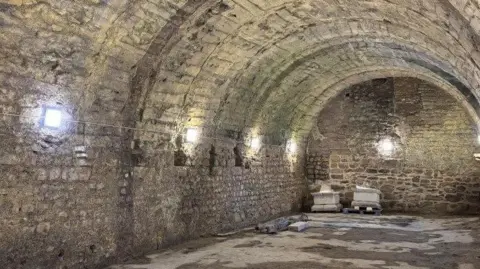Royalty, wine and shelter: Inside a medieval vault
 Southampton City Council
Southampton City CouncilBehind an inconspicuous pair of doors in a city centre, lies a vault once used for royalty, wine and war-time shelter.
Castle Vault in Southampton was built in the 12th Century to store the King's wine at a time when the port was at the centre of the wine trade.
It was largely forgotten about until the 1770s when some builders accidentally knocked through, uncovering the historic space.
Radio Solent's Alex Hopwood ventured underground to learn more about the 800-year-old vault that lies beneath the Hampshire city.
Castle Vault is one of about 60 vaults that were built in Southampton between the 12th and 15th centuries.
Once part of Southampton Castle, it has outlived the castle itself.
The castle stayed in royal hands until the early 17th Century, when it was sold by the Crown and "effectively demolished", said Southampton City Council's learning and engagement officer, Andy Skinner.
Standing beneath the curved stone ceiling of the vault, Mr Skinner said: "The gateway and windows were likely blocked up, so, for a long time people would have just walked past and not known very much about it.
"Until the 1770s, when - above us - some builders accidentally chopped through into the vault and they peered in, presumably with a lantern, and saw this amazing space."
He added there would have been ornate ribs, "almost like the skeletons of a vault" inside at that time.
"Within about 50 years, all of that had been taken out."
Blast walls
Fast forward to World War Two and the vault was used as an air raid shelter.
There were approximately 100 underground spaces in Southampton that were converted into shelters, including vaults, cellars and basements.
Extra walls, known as blast walls, were built and their remnants can be seen on the ceiling of Castle Vault today.
"We know that there were chemical toilets," said Mr Skinner. "We know that you entered via a gas-proof curtain and we know that this was designed for accommodating 170 people during the Southampton Blitz.
"Difficult to imagine how it must have felt to have been in here while the bombs were falling, particularly in November and December 1940, which is when Southampton was very badly hit."
'Barred windows and gates'
In the 12th Century, when the 56ft by 20ft (17m by 6m) vault was created, the city was becoming an important importer of wine from France.
"One of the forms of tax in those days was that one in every 10 barrels of wine could go to the King - the King's Prize," Mr Skinner explained.
"This was his vault for storing his wine, which explains why it is so much larger than all of the others in Southampton."
Its solid construction, using stone from the Isle of Wight and some from further afield in Conne, France, meant the monarch's valuable wine haul was well-protected.
"The walls are incredibly thick, thicker than the other vaults in Southampton," said Mr Skinner. "They are, at their widest point, perhaps 10ft (3m).
"Barred windows and gates would have made it quite tricky to get into it, padlocked gateways.
"We do know that Southampton was raided in the 14th Century by primarily French attackers. We know that they did steal wine, though it appears most of that was on ships. It is unknown whether they made it as far as the King's vault."
Today, the vault can be hired for small scale events, such as exhibitions, filming and ghost hunts.
But the council warns: "In order for the vaults to retain their historical integrity for future generations, we have made only minor concessions to modern comforts!"
You can follow BBC Hampshire & Isle of Wight on Facebook, X (Twitter), or Instagram.
